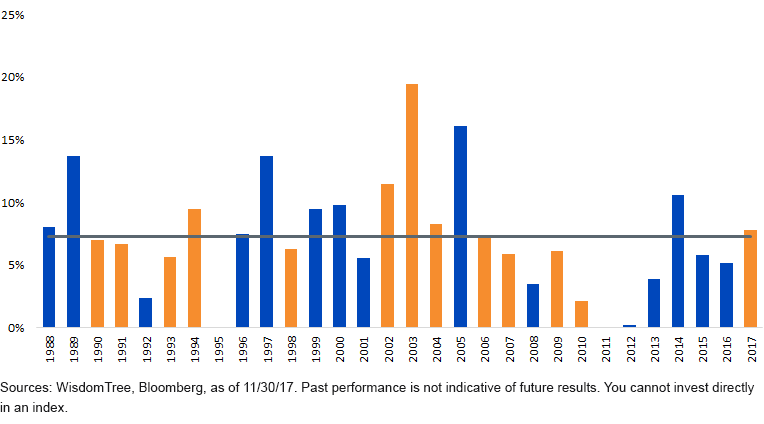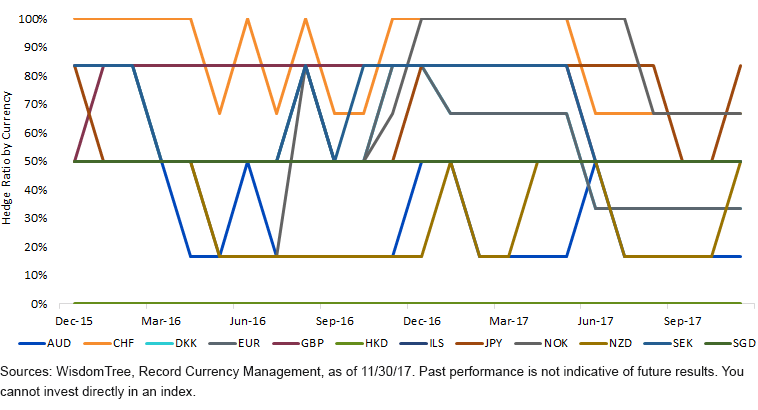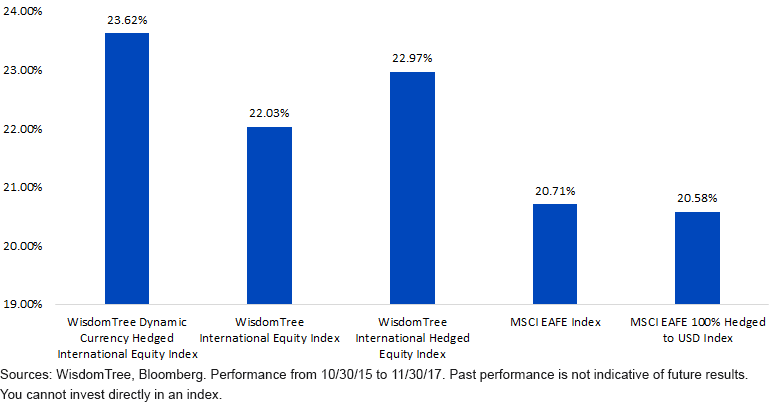Don’t Start the Race from Behind the Starting Line


We feel strongly about helping our clients understand the impact that currencies have on international equity returns. Over the long run, we believe that currency exposure in developed markets represents an uncompensated risk: it provides almost no expected return but often contributes additional volatility. That said, we can acknowledge that a hedged position can have bouts of underperformance, as 2017 has proven in spades. With almost all G10 currencies having rallied against the dollar this year, we will be the first to concede that there are periods of time when hedging can be an uphill battle.
Year-to-date through November 30, the MSCI EAFE Index was up over 23%. However, many investors may not realize that over a third of that total return has come from the currencies themselves, and the gap between being hedged and unhedged stood at 7.8%. While this represents a large absolute spread, 2017 is hardly an outlier. In fact, over the last 30 years, the average calendar year performance difference between being hedged and unhedged has been 7.3% per year.
Gap Between MSCI EAFE Hedged (Blue = Hedged Outperformed; Orange = Unhedged Outperformed)

Clearly, for investors allocating internationally, getting the hedging decision “right” can have a massive impact on the overall performance of their portfolios. Being on the wrong side of this trade is akin to a marathon runner starting the race from far behind the starting line. Consider this: to overcome a 7.3% headwind, a portfolio’s stock performance better be pretty dang good.
Split the Difference?
One way to mitigate this risk is to split the difference by always taking a 50% hedged position. While this represents an improvement over simply ignoring currency exposure, the problem with this approach is that hedging half of your currency exposure implies that you are indifferent to each underlying currency and that you believe the future prospects of each are identical. Every individual currency has its own nuances and financial conditions at any given moment, from a number of different perspectives.
- Valuation: While some currencies currently look cheap on a purchasing power parity basis (such as the euro and yen), others appear more expensive (such as the franc, currently overvalued by more than 20%1).
- Cost: Even before accounting for the Federal Reserve (Fed) raising rates this week, investors are getting paid more than 1.6% annually to hedge out their euro exposure2– an amount that will only increase as the Fed continues along its rate hike cycle. On the flip side, there is a net cost to hedge the Australian dollar due to the relatively higher interest rates there.
- Momentum: The euro has appreciated strongly against the dollar in 2017, but others have trended weaker in recent months (such as the yen, which has depreciated against the dollar since the end of the first quarter).
Given the constantly changing landscape of the currency markets, we think that a blanket approach that treats all currencies the same is less than ideal.
Dynamic Hedging: Two Great Ideas in One
To adapt to the changing dynamics of the currency markets, we think one of the best approaches is exactly that: dynamic. Employing a systematic hedging system can take advantage of currencies that should appreciate against the dollar while simultaneously hedging out exposure from those that may fall.
We took several of our existing dividend-weighted international equity indexes (which already have proven since their inceptions to add between 80 basis points (bps) and 150 bps of annualized outperformance above comparable cap-weighted indexes3) and partnered with Record Currency Management to implement a dynamically hedged overlay on top. This takes some of the best ideas from two experts in their respective fields and provides investors with a solution to the hedging dilemma. The appeal to investors is simple: wipe your hands clean of the hedging decision and let the rules-based approach make it for you.
Since launching our dynamic Indexes in 2015, we’ve seen the hedge ratios for most of the underlying currencies shift dramatically due to changing market conditions. The hedging indicators have certainly been active, and we believe that these fluid exposures are merely a reflection of what is required in today’s changing markets.
Dynamic Hedge Ratio by Currency

Hedged vs. Unhedged vs. Dynamic
Compared to the performance of a 50% heded exposure, which will always fall in between fully hedged and unhedged, a dynamic approach has the potential to outperform both. Lending validation to the process, since its inception the WisdomTree Dynamic Currency Hedged International Equity Index has done exactly that, having outperformed both the hedged and unhedged versions of the exact same equity basket (an equity basket that notably has also outperformed the market on its own). Given the sizable moves by the dollar—in both directions—over the last two years, our conviction that a dynamic approach is necessary has only grown since then.
Performance Since Inception of WisdomTree Dynamic Currency Hedged International Equity Index

While we don’t claim to know where any given currency will go tomorrow, we do think we know of a way for investors to position their portfolios for whatever tomorrow’s currency markets may bring.
Sometimes the best decision investors can make is one that is made for them.
1Source: Bloomberg, as of 11/30/17.
2Source: FactSet, as of 9/30/17.
3Source: Bloomberg, as of 9/30/17.


